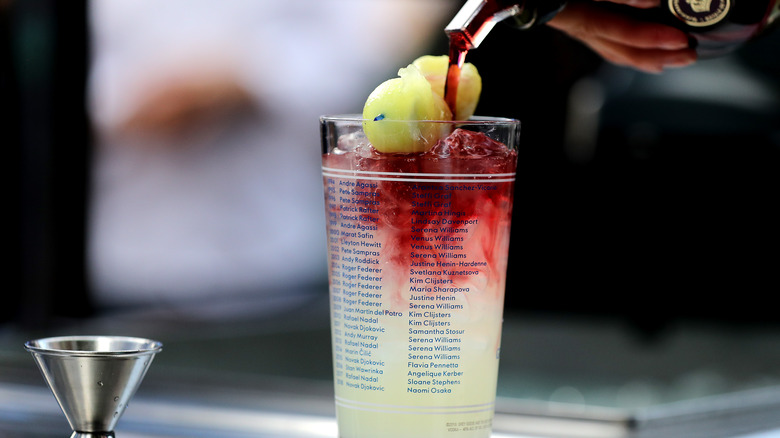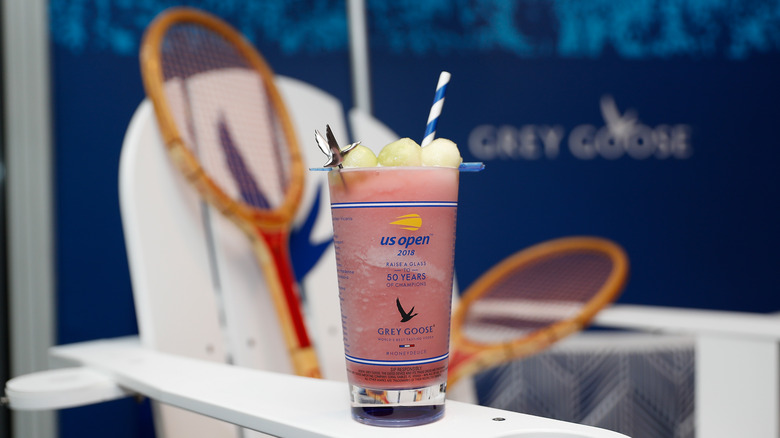What Is A Honey Deuce And When Do You Drink It?
We typically don't think of sporting events as an opportunity to enjoy a signature cocktail, yet here we are. It appears that toasting an event — its winners as well as its losers — is a thing, which is why some of the world's biggest tournaments have a drink associated with it.
DrinkedIn helpfully provides a list of boozy drinks that enjoy a place of honor at some of the world's most storied sporting events. If you're over the age of 21, you'll have access to a mint julep at the Kentucky Derby or a Pit Lane Lemonade at the Indy 500. Golf fans watching The Masters in Augusta (either on television or IRL) can enjoy the Azalea Cocktail. Across the pond in Britain, where the drinking age is 18, Wimbledon watchers can cool down with the royals' drink of choice, a Pimm's Cup.
Closer to home, the drink of choice for fans of the U.S. Open is the Honey Deuce.
This is when the Honey Deuce introduced
Unlike the bourbon-based mint julep, which has been associated with Churchill Downs and the Kentucky Derby in 1938, and Wimbledon's Pimm's Cup, which was served in 1971, the Honey Deuce's associations with the U.S. Open don't go back very far. While the first U.S. Open, one of the oldest tennis competitions in the world, took place in 1881 (via Britannica), the drink wasn't introduced until 2007, well over a hundred years later.
Its relative youth notwithstanding, the Honey Deuce appears to be growing in popularity among fans at the U.S. Open, because as Forbes reports, more than a million of the specialty drinks have been sold since it was introduced. The publication tracks back the Honey Deuce's popularity to 2016, when 193,000 Honey Deuces were served; that number ticked up to 201,00 a year later. It rose to nearly 223 thousand the year after that, even though Forbes priced the drink at $20 in 2019, and comes in a souvenir container (via USA Today).
This is how the Honey Deuce is made at the U.S. Open
Honey Deuces take their name from the word "deuce" — the technical term used to describe a tied score of 40-40, and was crafted by Grey Goose vodka mixologist Nick Mautone. The drink brings together Grey Goose Vodka, Chambord or another raspberry liqueur of your choice, and lemonade, served in a highball glass. The drink is garnished with honeydew melon balls skewers, which are reminiscent of green tennis balls flying across the court.
Getting Honey Deuces ready during the big event isn't easy. Forbes says as many as 100 bartenders are enlisted to make and serve the drinks across 20 locations where the U.S. Open is held, and there is a dedicated team which is tasked with scooping out melon balls alone because the skewered fruit is always served fresh. Drink execs also say that every drink is made fresh to order, which could mean that no two drinks taste exactly the same (and that's a good thing!).
Here's how you can make the Honey Deuce at home
If you have no plans of heading courtside for the U.S. Open, you can make the drink at home and sip it as you watch the action on television (which might give you a better view anyway). Town and Country says that each highball glass of Honey Deuce takes one and quarter ounces of Grey Goose vodka, three ounces of freshly squeezed lemonade, and a half ounce of raspberry liqueur like Chambord, as well as honeydew melons for garnish (you can use frozen fruit if you're at home and you're not bothered).
The Spruce Eats says using freshly squeezed lemonade is important because premixes could be too sweet for your liking. And while the option to use a lower, cheaper grade of vodka is certainly there, there's no real reason to make the switch. The Honey Deuce packs an ABV of about 10%, which The Spruce Eats equates to a light wine. And if you're counting calories, myfitnesspal sets the Honey Deuce at 281 calories of which 7 grams are carbs.



